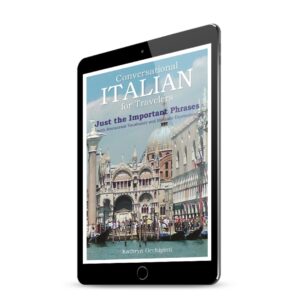Every day, we all compare the characteristics of one person, place or thing to another — and many times these characteristics are similar or the same. For instance, there are so many places in Italy that are beautiful, and one may be as beautiful as another! Or one place in Italy may have as many important sites of interest as another. In these cases, to make a comparison we must use the Italian adverbs come and tanto… quanto to relay the meanings “as,” “as well as,” and “as much as.”
When comparing two different nouns — people, places, or things — using the same adjective or adverb, the effect will be a statement that their description is equivalent. It is as if you are saying one person, place or thing is “just like” the other.
Use the following Italian adverbs in the table below when you want to make a comparative statement of equality:
| Comparison of Two Nouns with Equivalent Descriptors |
| come così come |
as, like, just like is as |
| tanto…. quanto | as…as, like, just like, as well as |
It should be noted that the definitions of the adverb come encompass those of many English adverbs and adverbial phrases, such as: “as,” “same as,” “like,” or “just like.” In effect, then, the single adverb come can relay all of these meanings when comparing two nouns. The combination “così come” is used specifically to say someone or something “is as” expected. And remember that when così is used alone, without making a comparison between one noun and another, the meaning is “so.”
The alternate method of comparing two is nouns with equivalent adjectives is to use tanto…. quanto.
In the tables below, we start with an example that uses così to make a general statement. Then, examples of how to use the adverbs come and tanto… quanto as comparatives of equity are listed. Two examples using così come are also provided. Notice that the comparisons made are between nouns — two persons, places, or things.
Comparison of two persons with the same adjective (equivalent characteristics):
| Francesca è così bella. | Frances is so beautiful. |
| Francesca è bella come Anna. | Frances is beautiful, (just) like Ann. |
| Francesca è tanto bella quanto Anna. | Frances is as beautiful as Ann. |
| Francesca è così come te l’ho descritta. | Frances is as I have described to you. |
| Marco è così intelligente. | Mark is so smart. |
| Marco è intelligente come Franco. | Mark is smart, (just) like Frank. |
| Marco è tanto intelligente quanto Franco. | Mark is as smart as Frank. |
| Marco è così come lo immaginavo. | Marco is as I had expected. |
Comparison of two places with the same adjective (equivalent characteristics):
| Milano è così rumorosa. | Milan is so noisy. |
| Milano è rumorosa come Roma. | Milan is noisy, (just) like Rome. |
| Milano è tanto rumorosa quanto Roma. | Milan is as noisy as Rome. |
| Il Colloseo a Roma è così importante. The Colosseum in Rome is so important. |
| Il Colloseo a Roma è importante come il Duomo a Firenze. The Colosseum in Rome is important, like the Cathedral in Florence. |
| Il Collosseo a Roma è tanto importante quanto il Duomo a Firenze. The Colosseum in Rome is as important as the Cathedral in Florence. |
Comparison of two things with the same adjective (equivalent characteristics):
| La mia sedia preferita è così comoda. My favorite chair is so comfortable. |
| La mia sedia è comoda come le sedie fatto in America. My chair is comfortable, (just) like the chairs made in America. |
| La mia sedia è tanto comoda quanto le sedie fatto in America. My chair is as comfortable as the chairs made in America. |
Use tanto… quanto to compare nouns with equivalent adverbs. For instance, to say one machine works as well as another similar machine. In this case, quanto can stand alone to represent the full meaning, “as well as.“
La mia Camaro va tanto bene quanto la tua Ferrari.
My Camaro runs as well as your Ferrari.
– or-
La mia Camaro va bene quanto la tua Ferrari.
More Uses of “Tanto… Quanto”
for Equivalent Italian Comparisons
Use tanto… quanto to describe two characteristics of a single individual, in order to say someone is as (much) one way as he/she is another way. As an example, if someone is both smart and handsome, one might want to emphasize the special nature of this individual by putting both characteristics in one statement. In this case, the verb essere is used for the comparison to “link” both characteristics to the subject. This works for places and things as well. Note that tanto cannot be omitted in this situation.
| Two Equivalent Characteristics for a single individual, place, or thing |
| tanto… quanto | as… as |
| Marco è tanto intelligente quanto bello. | Mark is as smart as handsome. |
| Il film era tanto lungo quanto noioso. | The film was as long as it was boring. |
| Roma è tanto rumorosa quanto grande. | Rome is as noisy as it is large. |
When comparing the quantity of things two people have, to state that different individuals have an equivalent quantity, use the adverbs tanto…quanto. Note that in this situation tanto must always be used with quanto and tanto must agree in gender and number with the noun that it modifies.
| Comparison of Two Equivalent Quantities |
| tanto(a,i,e)…. quanto | as many… as as much…as |
This adverbial phrase will usually appear with the verb avere to describe in general how much or how many things someone has. Since we are now speaking of quantities, we need to include the pronoun ne, which means, “of it,” “of this,” or “of that” in this situation, and ne will appear before the conjugated form of avere in the second phrase.
| Caterina ha tante amiche quanto ne ha Anna. | Kathy has as many friends as Ann. |
| Pietro ha tanti parenti quanto ne ha Caterina. | Peter has as many relatives as Kathy. |
| Le persone a Milano hanno tanti soldi quanto ne ha la gente a Roma. |
The people in Milan have as much money as the people in Rome. |
“Come”
in Italian Sayings
Along with the frequent use of the adverb come to make comparisons daily life, Italians often pepper their conversations with well-known sayings that use come. Many Italian sayings, or figures of speech that describe one thing by comparing it to another, have been passed down for generations and are still in use throughout Italy today. Therefore, learning about the adverb come will help us to understand both the Italian language and Italian culture!
With a figure of speech that describes one thing being “like” or “as” another using come, Italians are able to express their point in a creative and often humorous way. In other cases, a comparison can add emotion or depth to a statement. In grammatical terms, a figure of speech that uses like, or its Italian equivalent come, is called a simile. A short statement that uses a simile is often called a saying. The descriptor “saying” is often used in interchangeably with “proverb,” although proverbs tend to make a more strong association between two points, using a metaphor with the verb “is” to create a universal statement.
Let’s see how Italians use the adverb come with the meaning of “like” or “as” to make a simile and underscore a point that is important to the speaker.
Probably the most common simile used in Italy today is, “Buono come il pane.” The literal meaning is, “Good like the bread.” An outsider may wonder why a person is being compared to bread. What point could this make? Similes, like proverbs, do not always make sense when translated word for word. In this case, bread is alluded to because of the central place bread has had in sustaining life in Italy throughout the ages. An English an equivalent saying might be, “Heart of gold,” or “Good of heart,” to describe someone who is particularly caring and understanding and supportive of another’s needs.
A few more well-known Italian sayings are listed below. You’ll notice that the similes used in these sayings also compare a particular type of person to a particular type of food. Do you know any other situations in which Italians compare people to food to make a point? If you’d like, leave any I have not included in the comments below so we all can enjoy the Italian sensibility!
Ognun dà pane ma non come mamma.
Translation: Everyone gives bread but none does it like a mother.
Meaning: A mother’s love is special.
Sono pieno come un uovo.
Translation: I’m full like an egg.
Meaning: I am stuffed! I ate a lot and now am as full as can I can be. An egg is a good comparison because the thin shell is completely filled with the yolk and white; no space is left for anything else.
Sei come il prezzemolo!
Translation: You are like parsley!
Meaning: You turn up everywhere! I seem to encounter you everywhere I go! Parsley is a well-known herb in Italy, both for its ability to grow everywhere and also because a little parsley is used here and there in many Italian dishes.
Spuntare come funghi.
Translation: Sprouting up like mushrooms.
English: How did you get here already? To show up or emerge from somewhere quickly. Mushrooms are known for their ability to sprout quickly after a period of rain — so quickly that it seems like one day there is nothing and the next day there are clumps of fully grown mushrooms everywhere.
Remember how to make comparisons with
come and tanto/quanto and I guarantee you will use these
Italian phrases and Italian sayings every day!
For “All the Italian you need to enjoy your trip to Italy,” click on the links below to purchase my Conversational Italian for Travelers books – Kathryn Occhipinti


 Fra Noi Embrace Your Inner Italian
Fra Noi Embrace Your Inner Italian





